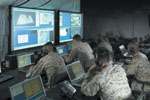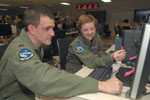Range Accelerates Information Operations Planning
 |
| Combat operations centers (COCs) such as this one developed by General Dynamics C4 Systems for the U.S. Marine Corps are often the nexus of decisions about the use of nonkinetic weapons during operations. COCs feature computerized intelligence, information and communication systems that can be employed to take an appropriate information operation action. |
Combatant commanders now have a place to test, train, evaluate and develop nonkinetic alternatives to fight in the Global War on Terrorism. The
Both the range and the environment operate under the auspices of the Information Operations Joint Management Office (IO JMO) at U.S. Joint Forces Command (JFCOM) in
The IO Range allows JFCOM to virtually or in a distributed environment connect shooters and capabilities so the military can evaluate a variety of activities, from live fires to analysis. “You always hear about distributed operations. Well, in our world, that has not been feasible until the range came along,” he explains.
Thomason describes the IO JMO as an enabler. It is not uncommon for the office to link a live-fire range in
“Let’s talk about computers on the computer network defense side of it. How do you develop an environment [in which] you can actually test or train against that type of target?” Thomason relates. For example, users of home computers may install products such as Norton utilities for security. These tools can either stop a virus or remove it once it has taken root. However, it is difficult to determine how a virus would affect a network without doing malice to the network. “How would you represent the Internet without actually going to the Internet? Well, there is no one facility that has all those capabilities in one place, because IO assets are limited to begin with. So what we do is link them together and begin to configure so that we can actually take appropriate actions that we need to test or train our actual capabilities,” he relates.
Typically, the IO JMO works with the combatant commands’ operations directorate (J-3). These directorates are a wealth of information about targets as well as less-specific items such as whether a service capability can respond in a particular area of responsibility.
“If I’m worried about target X or somebody doing something to me, what do I have within the Defense Department inventory to combat that? In the old days, because of policy and no way to actually demonstrate or test this, we had no way to go back and say, ‘Hey, let me show you how this works. Let’s go out and create the scenario you’re trying to plan to, and let’s see where the real issues are.’ In the old days, it was a guy behind a classified door who would come out and say this happened. There was no way to validate that. You’re asking the commander to take it on faith.
”We don’t have to do that anymore. Now, we have the ability to test this, train to it, demonstrate it and live-fire it in response to that combatant commander. And we’re doing it using his plan, using his people and with him integrated with our people during the exercise,” he explains.
Thomason uses a hypothetical situation to describe how the IO Range works. For example, if a leader from a hostile country or terrorist organization was assassinated, the tendency would be to suspect the
“Let’s say we came up with four or five concepts of messages that we would want to send out. Potentially, those messages could even create second- and third-order effects. This guy does A, it causes this guy to do B. Well, tell me how you would rehearse prior to actually sending those messages out? How would you codify the potential impact of that message set before you sent it out?” he says.
With a range, the IO JMO has the ability to reach back into databases, into simulations and into human models and behaviors. It can create a group from a specific country that has the same tendencies and reactions given certain circumstances. “Then we can build this message set, and we can link into that database and that simulation, we can run it, and we can make some kind of an educated assessment of how that message would influence that specific group,” Thomason relates.
Some of the actions that could be taken include physically entering a region, launching a denial-of-service attack, taking a Web site offline for a day and preparing for riot control. Other potential actions include publishing information on friendly Web sites or in other media or remaining silent.
In the past, a commander would weigh options based on intuition and experience. “With the range, we’re giving him an enabler or a tool. He might link back through us to multiple different elements and could say, ‘I want you to simulate me putting out this message.’ We’re going to use the range to set up that environment so now it’s not him doing guesswork about how an option is going to work. We’re giving him an educated and analytical assessment of whether or not action A or action B or action C would work,” Thomason explains.
The IO Range project was chartered in November 2005; the IO JMO was given nine months to prove the concept would work. By August 2006, Thomason says with some pride, the range had completed four events and proved that it could link—in a classified environment—capabilities that were located both inside and outside of the continental
 |
| U.S. Air Force augmentees monitor air operations in the Major Richard Bong Air and Space Operations Center (AOC) during a joint exercise. The AOC is the U.S. Pacific Command’s operational center for the command and control of planning, execution and assessment of air, space and information operations in the Asia Pacific region, excluding the Korean theater of operations. The Information Operations Joint Management Office at U.S. Joint Forces Command enables combatant commands to explore nonkinetic weapons options before taking action. |
He emphasizes that the IO JMO is a supportive element to the services and does not own its own capabilities. Instead, it links others’ capabilities and integrates them to test options to determine their odds of success. “I couldn’t make this happen without the services. No way,” he asserts.
COCOMs also have come to rely on the IO JMO for input about the less concrete aspects of IO. Thomason met with Lt. Gen. Robert J. Elder, USAF, commander, 8th Air Force (Air Forces Strategic), and joint functional component commander for global strike and integration, U.S. Strategic Command (STRATCOM). The general was interested in learning more about how to conduct command and control of many of his command’s cyber capabilities. Thomason admits that this is a very difficult question to answer, but the IO JMO is helping STRATCOM figure it out by acting as a concept testbed.
The IO JMO’s second primary program is the Virtual Integrated Support for the Information Operations Environment (VisIOn). An acquisition-based program, VisIOn is to the nonkinetic world what dozens of planning tools are to the kinetic world. In 2003, the Defense Department recognized that few assessment and analysis tools existed for IO. As a result, the department decided to launch a consolidated effort to develop a planning, integrated analysis and assessment environment.
To accomplish this task requires three elements: people, processes and tools, Thomason explains. STRATCOM provides the people, and the intelligence community addresses the matter of processes; the IO JMO was chartered to build the tools.
“We’re going more into a service-oriented architecture-type environment. We’re going more to an industry-type environment, where we can build these tools; we can make it collaborative in nature, and we can post them in a network environment; somebody else can download them, or use them, whatever they want to do. I always call it ‘The Google Tools for the IO planner.’ What we’ve been working on is first building that base environment, and then beginning to populate it with the appropriate tools,” Thomason explains.
To accomplish these tasks, the IO JMO is relying on its partners, he allows. For example, the office works with members of the intelligence community to define targets. Many times, intelligence agencies already are using their own tools to accomplish certain tasks, but then the information or analysis report must be re-keyed into another system so a COCOM can begin planning. To address this issue, the IO JMO currently is working on how to link these tools.
“So when one of the COCOMs says, ‘I need to develop a plan,’ we have tools to literally hook together all the disparate communities to come up with the right plan of action. So we’ve got the intel, planners, J-3, services—we call it a community of interest—all the right people there to build the right plan for that COCOM to move forward,” Thomason says.
Another example of the IO JMO’s enabling work is Pirate’s Dagger, which is part of a concept development science and technology series sponsored by the U.S. Air Force’s
Among the challenges the IO JMO faces is capacity, he admits. “There are a lot of elements within the IO business, within the services and agencies, and they’re doing outstanding things. We are very concerned about making sure that we can keep up with them. I’m talking about making sure that we can continue to grow our infrastructure and capacity in a manner that we’re able to continue to be responsive to what the warfighter is asking for,” he relates.
And the need for more capacity is likely to grow as Thomason works to expand into what he calls the untapped resource: industry. “It’s best for us to figure out how we can better bring the commercial sector into this environment so they can test, train and interact with IO capabilities.
”Now, there are some policies and rules that we’ve got to get through to bring industry in, but that’s going to be one of our next big challenges. We want to extend our capabilities out to the commercial sector because I think there is a very positive and fertile area to begin to work there. Contractors have got a lot of good ideas. We’ve got to create an environment that will allow them to play out these concepts in concert with the government. So I’m really looking forward to taking on that challenge and feel like the range will get there very shortly,” Thomason says. He hopes to accomplish this task within the next year, he adds.
Web Resources




Comments